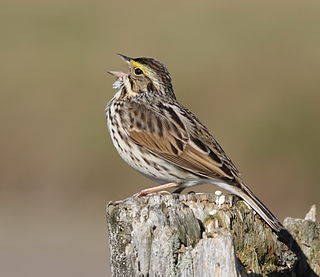
The Savannah sparrow is a small New World sparrow. It was the only member of the genus Passerculus and is typically the only widely accepted member. Comparison of mtDNA NADH dehydrogenase subunit 2 and 3 sequences indicates that the Ipswich sparrow, formerly usually considered a valid species, is a well-marked subspecies of the Savannah sparrow, whereas the southwestern large-billed sparrow should be recognized as a distinct species.

The yellow warbler is a New World warbler species. Yellow warblers are the most widespread species in the diverse genus Setophaga, breeding in almost the whole of North America, the Caribbean, and down to northern South America.

Isla Todos Santos is a pair of islands about 19.3 km (12.0 mi) off Ensenada, Baja California, at 31°47′59″N116°47′20″W best known for surfing. Access is only by boat, which can be rented in Ensenada, or La Bufadora. The waves off the smallest island are among the biggest in North America. There are no facilities on the islands except for two lighthouses and a fish farm operation.

The Herminiinae are a subfamily of moths in the family Erebidae. The members of the subfamily are called litter moths because the caterpillars of most members feed on dead leaves of plants, though others feed on living leaves.
Anthony's woodrat is an extinct subspecies of Bryant's woodrat in the family Cricetidae. It was found only on Isla Todos Santos in Baja California, Mexico. It is thought to have been driven to extinction through predation from feral cats.
Bryant's woodrat is a species of new-world rodent in the family Cricetidae native to the Southwestern United States and Mexico.
Bunker's woodrat is an extinct subspecies of Bryant's woodrat in the family Cricetidae. Only five specimens are known; these were collected in 1932 by W.H. Burt and are housed at a museum at UCLA. Neotoma bunkeri was only described from Coronados Islands, Baja California, Mexico. It probably died out as a result of depletion of food resources and predation by feral cats.
The San Martín Island woodrat is an extinct subspecies of Bryant's woodrat in the family Cricetidae.

The cactus wren is a species of wren endemic to the deserts of the southwestern United States and northern and central Mexico. It is the state bird of Arizona, and the largest wren in the United States. Its plumage is brown, with black and white spots as markings. It has a distinctive white eyebrow that sweeps to the nape of the neck. The chest is white, whereas the underparts are cinnamon-buff colored. Both sexes appear similar. The tail, as well as flight feathers, are barred in black and white. Their song is a loud raspy chirrup; akin in the description of some ornithologists to the sound of a car engine that will not start. It is well-adapted to its native desert environment, and the birds can meet their water needs from their diet which consists chiefly of insects, but also of some plant matter. The cactus wren is a poor flier and generally forages for food on the ground. Ornithologists generally recognize seven subspecies, with the exact taxonomy under dispute.
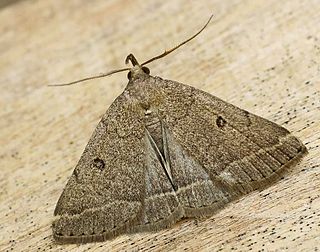
Zanclognatha zelleralis, the dusky fan-foot, is a species of moth of the family Noctuidae. It was described by Maximilian Ferdinand Wocke in 1850. It is found in central and southern Europe.
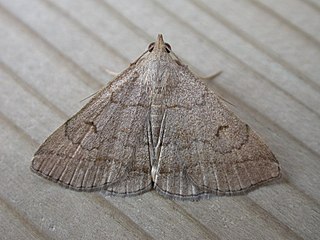
Zanclognatha lunalis, the jubilee fan-foot, is a moth of the family Noctuidae. The species was first described by Giovanni Antonio Scopoli in his 1763 Entomologia Carniolica. It can be found across the Palearctic realm.

Zanclognatha is a genus of litter moths of the family Erebidae. The genus was erected by Julius Lederer in 1857.
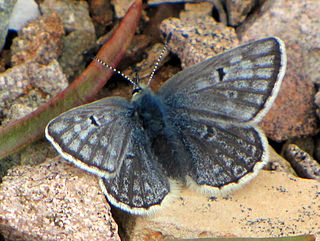
Agriades glandon, the Arctic blue or Glandon blue, is a species of butterfly in the family Lycaenidae. It in found in Eurasia and North America.
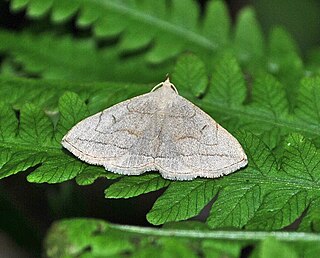
Zanclognatha pedipilalis, the grayish zanclognatha, is a litter moth of the family Erebidae. The species was first described by Achille Guenée in 1854. It is found in eastern North America, from Nova Scotia south to Florida and Mississippi, west to Alberta and Kansas.

Zanclognatha cruralis, the early zanclognatha, is a species of litter moth of the family Erebidae. It is found from Wisconsin east through southern Canada, south to Florida and Texas.

Zanclognatha jacchusalis, the wavy-lined zanclognatha, is a litter moth of the family Erebidae. It was described by Francis Walker in 1859. It is found in the US from Wisconsin to Maine, south to Georgia and Louisiana.

Zanclognatha laevigata, the variable zanclognatha, is a litter moth of the family Erebidae. It was described by Augustus Radcliffe Grote in 1872. It is found in North America from Manitoba to Nova Scotia, south to Florida and Missouri.

Zanclognatha lituralis, the lettered zanclognatha, is a litter moth of the family Erebidae. It was described by Jacob Hübner in 1818. It is found from in North America from Wisconsin to Nova Scotia, and south to Florida and Texas.

Zanclognatha martha, the pine barrens zanclognatha or Martha's zanclognatha, is a litter moth of the family Erebidae. It was described by William Barnes in 1928. It is found from Ohio to Maine, south in the mountains to North Carolina and along the Coastal Plain to Texas. It is listed as threatened in the US state of Connecticut.
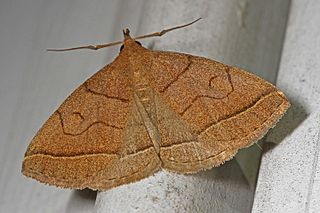
Zanclognatha obscuripennis, the dark zanclognatha, is a litter moth of the family Erebidae. It was described by Augustus Radcliffe Grote in 1872. It is found in North America from Missouri to Quebec, south to Florida and Texas.















